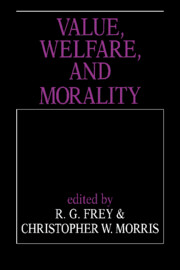Book contents
- Frontmatter
- Contents
- List of contributors
- Preface
- 1 Value, welfare, and morality
- 2 The land of lost content
- 3 Putting rationality in its place
- 4 Can a Humean be moderate?
- 5 Welfare, preference, and rationality
- 6 Preference
- 7 Reason and needs
- 8 Desired desires
- 9 On the winding road from good to right
- 10 Value, reasons, and the sense of justice
- 11 Agent-relativity of value, deontic restraints, and self-ownership
- 12 Agent-relativity – the very idea
- 13 The separateness of persons, distributive norms, and moral theory
- 14 Harmful goods, harmless bads
2 - The land of lost content
Published online by Cambridge University Press: 07 December 2009
- Frontmatter
- Contents
- List of contributors
- Preface
- 1 Value, welfare, and morality
- 2 The land of lost content
- 3 Putting rationality in its place
- 4 Can a Humean be moderate?
- 5 Welfare, preference, and rationality
- 6 Preference
- 7 Reason and needs
- 8 Desired desires
- 9 On the winding road from good to right
- 10 Value, reasons, and the sense of justice
- 11 Agent-relativity of value, deontic restraints, and self-ownership
- 12 Agent-relativity – the very idea
- 13 The separateness of persons, distributive norms, and moral theory
- 14 Harmful goods, harmless bads
Summary
This is the Land of Lost content
I see it shining plain.…
A. E. HousemanIdeals
What do we want from a theory of the content of ethical judgments? A great deal. Their truth must make metaphysical sense. That includes having an intelligible relation with the natural facts on which they supervene. It must be possible to know them, and say how we do – but also possible to make sense of various kinds of skepticism. It must be possible to say what place they have in our lives, and that will include making sense of their motivational power and their curiously fragile objectivity. Because a whole philosophical industry depends on it, it ought to be possible to say to what extent they are fit objects of difficult theory, and to what extent such a theory would appeal to all rational people. It would be good to know what someone must share with us to count as using ethical terms with the same sense, and good to know to what extent the judgments we make are on all fours with other kinds of judgment. I consider these notions in order below.
I have long argued that one kind of theory provides the best combination of answers to all these problems. This is a “projective” theory, starting in the same corner as traditional emotivism and prescriptivism, but taking certain critically different options. The starting point is to recognize a “nondescriptive” or expressive function for states of assent to ethical judgment.
- Type
- Chapter
- Information
- Value, Welfare, and Morality , pp. 13 - 25Publisher: Cambridge University PressPrint publication year: 1993



